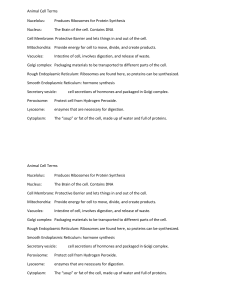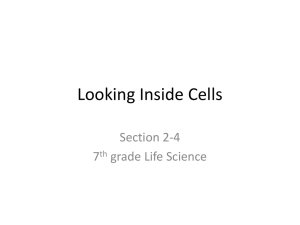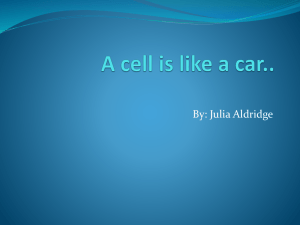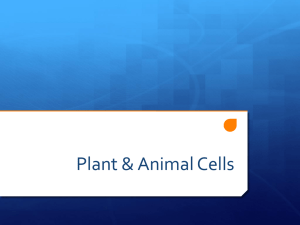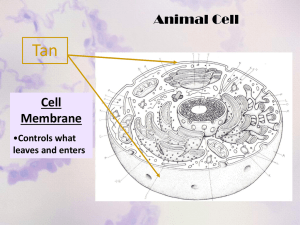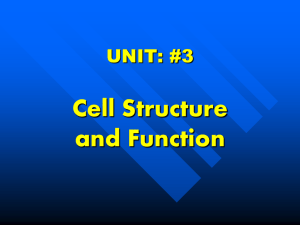Chapter 7 Cells 18. Cells are very similar to a factory. 19. The
advertisement
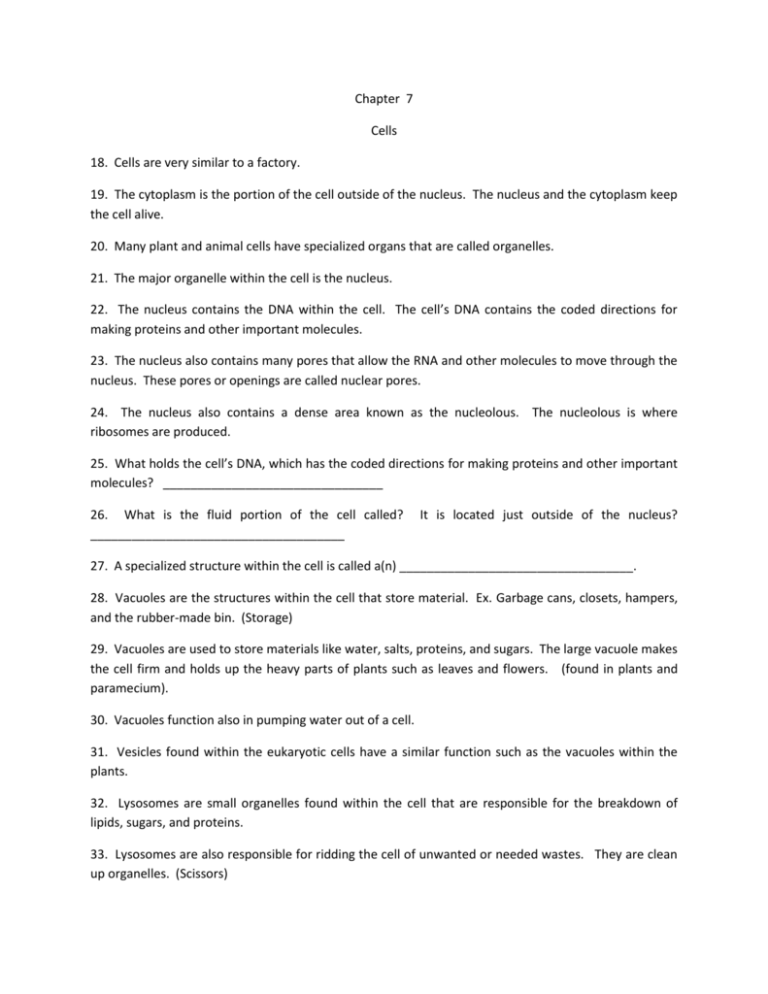
Chapter 7 Cells 18. Cells are very similar to a factory. 19. The cytoplasm is the portion of the cell outside of the nucleus. The nucleus and the cytoplasm keep the cell alive. 20. Many plant and animal cells have specialized organs that are called organelles. 21. The major organelle within the cell is the nucleus. 22. The nucleus contains the DNA within the cell. The cell’s DNA contains the coded directions for making proteins and other important molecules. 23. The nucleus also contains many pores that allow the RNA and other molecules to move through the nucleus. These pores or openings are called nuclear pores. 24. The nucleus also contains a dense area known as the nucleolous. The nucleolous is where ribosomes are produced. 25. What holds the cell’s DNA, which has the coded directions for making proteins and other important molecules? ________________________________ 26. What is the fluid portion of the cell called? _____________________________________ It is located just outside of the nucleus? 27. A specialized structure within the cell is called a(n) __________________________________. 28. Vacuoles are the structures within the cell that store material. Ex. Garbage cans, closets, hampers, and the rubber-made bin. (Storage) 29. Vacuoles are used to store materials like water, salts, proteins, and sugars. The large vacuole makes the cell firm and holds up the heavy parts of plants such as leaves and flowers. (found in plants and paramecium). 30. Vacuoles function also in pumping water out of a cell. 31. Vesicles found within the eukaryotic cells have a similar function such as the vacuoles within the plants. 32. Lysosomes are small organelles found within the cell that are responsible for the breakdown of lipids, sugars, and proteins. 33. Lysosomes are also responsible for ridding the cell of unwanted or needed wastes. They are clean up organelles. (Scissors) 34. The Cytoskeleton supports and gives shape to the cell. (support -beams and column) 35. Microfilaments are the threadlike structures that are made up of a protein called actin. Microfilaments often appear as internal webs that allow organisms such as Amoebas to move. 36. Microtubules are thin hollow pipes. They are made up of proteins known as tubulins. They help the cell maintain shape. They are found in structures such as cilia and flagella that help some organisms to swim. 37. Proteins are made on the ribosomes. Ribosomes are small units of RNA and protein found in the cytoplasm of all cells. (Ribosomes get information from DNA.) 38. The Endoplasmic Reticulum is a membrane system where lipid parts of the cell membrane are put together. Proteins and other materials that are shipped from the cell are also put together on the Endoplasmic Reticulum. 39. Two Types of Endoplasmic Reticulum _______________________________________________________ _______________________________________________________ 40. The Rough Endoplasmic Reticulum (RER) is called this because it has _________________________ on its surface which makes it bumpy. 41. The Smooth Endoplasmic Reticulum (SER) is ________________________ because it lacks ribosomes. 42. The ribosomes produce proteins that can enter the Endoplasmic Reticulum. These proteins then eventually leave the cell. 43. The Smooth Endoplasmic Reticulum make membrane lipids and get rid of toxins such as drugs. 44. The Golgi Apparatus is a flattened stack of membranes that changes, sorts, and packages proteins and other materials from the Endoplasmic Reticulum. 45. Proteins are put together on ribosomes>Proteins that will leave the cell fold into their correct shape in the Endoplasmic Reticulum> The Endoplasmic Reticulum makes vesicles that carry the proteins to the Golgi Apparatus or Golgi Body>The Golgi Apparatus modifies proteins, sorts and pack them in new vesicles>Proteins ride in the vesicles to other parts of the cell or they go to the cell membrane in order to leave the cell. 46. All living things need energy to live. Directly or indirectly all living things have to eat ________________ which get there energy from the ___________________. 47. Plants make their food by using CHLOROPLASTS. _______________________ which makes food. Chloroplasts contain a green substance called 48. Nearly all Eukaryotic cells contain __________________________. These structures are the “Powerhouse” of the cell. (Think of a Power plant which supplies communities with electricity) Mitochondria convert chemical energy stored in food into compounds that the cell can use. 49. Chloroplasts provide the plant cell with energy. 50. Mitochondria provide the animal cells and plant cells with energy.


